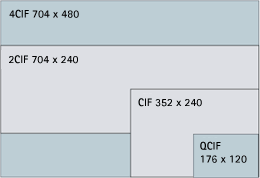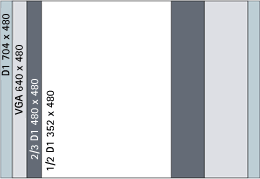 |
 |
|
|
 |
Resolution
Resolution is similar in the analogue or digital worlds, but there are important differences in how it is defined. In analogue video, the image consists of lines, or TV lines, since analogue video technology is derived from the television industry. In a digital system, the picture is made up of pixels (picture elements). The resolution of digital cameras is measured by the number of effective pixels on the image sensor chip.
Topics covered below involve:
NTSC and PAL Resolutions
In North America and Japan, the NTSC standard (National Television System Committee) is the predominant analogue video standard, while in Europe the PAL standard (Phase Alternation by Line) is used. Both standards originate from the television industry. NTSC has a resolution of 480 lines, and uses a refresh rate of 60 interlaced fields per second (or 30 full frames per second). PAL has a resolution with 576 lines, and uses a refresh rate of 50 interlaced fields per second (or 25 full frames per second). The total amount of information per second is the same in both standards.
When analogue video is digitised, the maximum amount of pixels that can be created is based on the number of TV lines available to be digitised. In NTSC the maximum size of the digitised image is 720x480 pixels. In PAL the size is 720x576 pixels (D1). The most commonly used resolution is 4CIF 704x576 PAL / 704x480 NTSC.2CIF resolution is 704x240 (NTSC) or 704x288 (PAL) pixels, which means dividing the number of horizontal lines by 2. In most cases, each horizontal line is shown twice, so called “line doubling”, when shown on a monitor in order to maintain correct ratios in the image. This is a way to cope with motion blur in interlace scan.
2CIF resolution is 704x240 (NTSC) or 704x288 (PAL) pixels, which means dividing the number of horizontal lines by 2. In most cases, each horizontal line is shown twice, so called "line doubling", when shown on a monitor in order to maintain correct ratios in the image. This is a way to cope with motion blur in interlace scan.
Sometimes a quarter of the CIF image is used, called QCIF short for Quarter CIF.
|
 |
| Different NTSC Resolutions |
Different PAL Resolutions |
 |
 |
|
 |
VGA Resolution
With the introduction of network cameras, 100% digital systems can be designed. This renders the limitations of NTSC and PAL irrelevant. Several new resolutions derived from the computer industry have been introduced, providing better flexibility and moreover, they are worldwide standards.
VGA is an abbreviation of Video Graphics Array, a graphics display system for PCs originally developed by IBM. The resolution is defined at 640x480 pixels, a very similar size to NTSC and PAL. The VGA resolution is normally better suited for network cameras since the video in most cases will be shown on computer screens, with resolutions in VGA or multiples of VGA. Quarter VGA (QVGA) with a resolution of 320x240 pixels is also a commonly used format, very similar in size to CIF. QVGA is sometimes called SIF (Standard Interchange Format) resolution, which can be easily confused with CIF.
Other VGA-based resolutions are XVGA (1024x768 pixels) and 1280x960 pixels, 4 times VGA, providing mega pixel resolution.
MPEG Resolution
|
 |
| MPEG resolution usually means one of the following resolutions: |
Resolutions used with MPEG |
| • 704x576 pixels (TV PAL)
• 704x480 pixels (TV NTSC)
• 720x576 pixels (PAL or D1)
• 720x480 pixels (NTSC or D1)
See more about MPEG
|
 |
|
 |
Mega pixel Resolution
The higher the resolution, the more details can be seen in an image. This is a very important consideration in video surveillance applications, where a high-resolution image can enable a criminal to be identified. The maximum resolution of NTSC and PAL, in analogue cameras, after the video signal has been digitised in a DVR or a video server, is 400,000 pixels (704x576 = 405,504). 400,000 equals 0.4 Mega pixels.
Using the CIF format, i.e. a quarter of the image, the resolution is down to a mere 0.1 Mega pixel.
Even though the video surveillance industry has always managed to live with these limitations, new network camera technology now makes higher resolution possible. A common mega pixel format is 1280x1024, giving 1.3 mega pixel resolution, 3 times higher than analogue cameras. Cameras with 2 mega pixel and 3 mega pixel are also available, and even higher resolutions are expected in the future.
Mega pixel network cameras also bring the benefit of different aspect ratios. In a standard TV, an aspect ratio of 4:3 is used, while movies and wide-screen TV use 16:9. The advantage of this aspect ratio is that, in most images, the upper part and the lower part of the picture are of no interest, yet they take up precious pixels, and therefore bandwidth and storage space. In a network camera any aspect ratio can be used.
|
 |
| Mega pixel network cameras also bring the benefit of different aspect ratios. In a standard TV, an aspect ratio of 4:3 is used, while movies and wide-screen TV use 16:9. The advantage of this aspect ratio is that, in most images, the upper part and the lower part of the picture are of no interest, yet they take up precious pixels, and therefore bandwidth and storage space. In a network camera any aspect ratio can be used.
In addition, digital pan/tilt/zoom can be achieved without losing resolution, where the operator selects which part of the mega pixel images should be shown. This does not imply any mechanical movement from the camera. It ensures much higher reliability.
|
 |
 |
|
 |
|
|
 |
|



